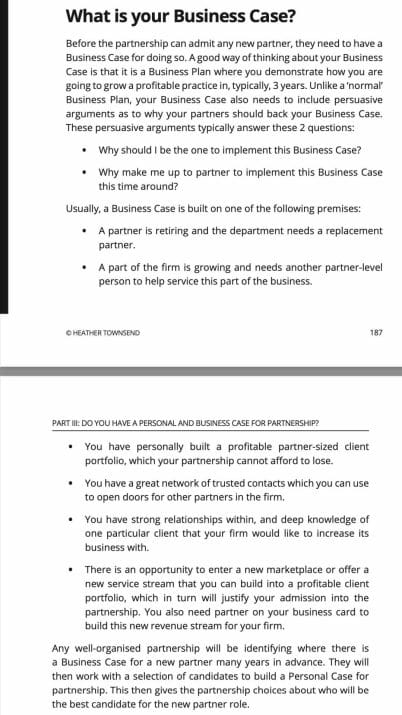You need to build your own Business Case for partnership. But did you know that all Business Cases are typically built on one of six premises? When you know WHAT premise your Business Case is built upon, writing a stronger and more persuasive Business Case becomes much easier. Read on to help you identify what premise your Business Case for partnership will be based upon.
The 3 steps to creating your Business Case for Partnership
Creating a cast-iron Business Case for partnership typically involves these three steps; building the Business Case, writing your Business Case and finally, pitching your Business Case to your partners. Unfortunately, many people naively think that their Business Case is something they write on a weekend, ready to be pitched later that week.
To avoid being one of those people who make that mistake, download our guide to creating your business case for partnership. It contains extracts from Chapter 11 of Poised for Partnership.
The reality is that creating a cast-iron Business Case for partnership normally takes a few years whilst you transition from having all your work handed down to you from your partner to being able to win and service all your own work.
The six premises every Business Case for partnership is based upon
I focus on your Partner Business Case in Chapter 11 of Poised for Partnership. Here is a screenshot of the part of the Chapter where I explain the 2 questions a Business Case for partnership needs to answer, and the 6 premises that every Business Case for partner is based on.

Most partnership Business Cases are typically built on one of these six premises:
- A partner is retiring, and the department needs a replacement partner. This premise for a Business Case for partner is normally very obvious to everyone concerned. In fact, this partnership vacancy is normally known years in advance. If this is going to be your Business Case for partnership, it’s typically a fairly strong Business Case. (It’s our favourite type of Partnership Business Case to work on with a client!) However, if your practice or the department as a whole is struggling to win work, then be aware that despite the strength of your Business Case, not every partner will want to invest in it.
- A part of the firm is growing and needs another partner-level person to help service this part of the business. This is normally the strongest Business Case there is to be had. It’s also a pretty easy Business Case for partners to evidence and get alignment too from your partners. Often a Big 4 Partner Business Case is based on this premise. Normally the Partner Business Case would heavily link into the service line and firm’s strategy.
- You have personally built a profitable partner-sized client portfolio, which your partnership cannot afford to lose. This is the most common type of Business Case for partners, and it is the weakest Business Case. There is often a big perception gap between what you think makes you too valuable to lose and what your partners think is too valuable to lose. Unless you have the backing of some pretty heavy-weight partners and they can clearly see how your practice adds incremental revenue to the firm, you may struggle to get this Business case for partner across the line. After all, it is very tempting for your partners not to make you a partner if they can see that you are doing what you are doing as a senior associate or director.
- You have a great network of trusted contacts, which you can use to open doors for other partners in the firm. People recruited in at the partner level who have been in industry are normally hired for this reason. This type of Business Case for partnership is rarely used by people within a firm who are hoping to be made up to partner. It is almost always used in a Business Case for a lateral hire.
- You have strong relationships and deep knowledge of one client your firm would like to increase its business with. This is often a strong Business Case for partnership. Your partners fear losing this normally big and really important client. They see that making you partner would help cement the relationship with the client AND tie you into the firm.
- There is an opportunity to enter a new marketplace or offer a new service stream that you can build into a profitable client portfolio, which in turn will justify your admission into the partnership. This Business Case for partnership only works if you also need Partner on your business card to build this new revenue stream for your firm. This reason for making partner is very common to see in Partnership Business Cases for litigators, deal makers and insolvency practitioners.
Any well-organised partnership will identify where there is a Business Case for a new partner many years in advance. They will then work with a selection of candidates to build a Personal Case for partnership. This then gives the partnership choices about who will be the best candidate for the new partner role.
To help you create, write or pitch your Business Case download our guide to creating your business case for partnership. It contains extracts from Chapter 11 of Poised for Partnership.
What’s in Progress To Partner which will help you with your Business Case for partner?
Progress to Partner is our membership site that will give your the knowledge AND confidence to fly through this final step up to partner.
It’s like a Netflix for your career in the professions. Find what you need to watch or read at the time you need it. Within the site, you’ll find over 150+ courses, videos, checklists, templates and plans to help you progress your career to partner. Amongst the many curated resources (no more unnecessary scrolling or searching), you’ll find:
- On-demand courses on how to create and articulate your business case, including our most downloaded course “How to Build a Cast-Iron Business Case for Partner”
- A section on the Partnership Admissions process with guides and recordings to help you find your way through the process with your sanity intact.
- Recordings and checklists on how to ace your partner panel interview
- On-demand courses on how to win the right sort of clients
- Proven advice on how to still do the day job and find the time to get through the Partner Track process








